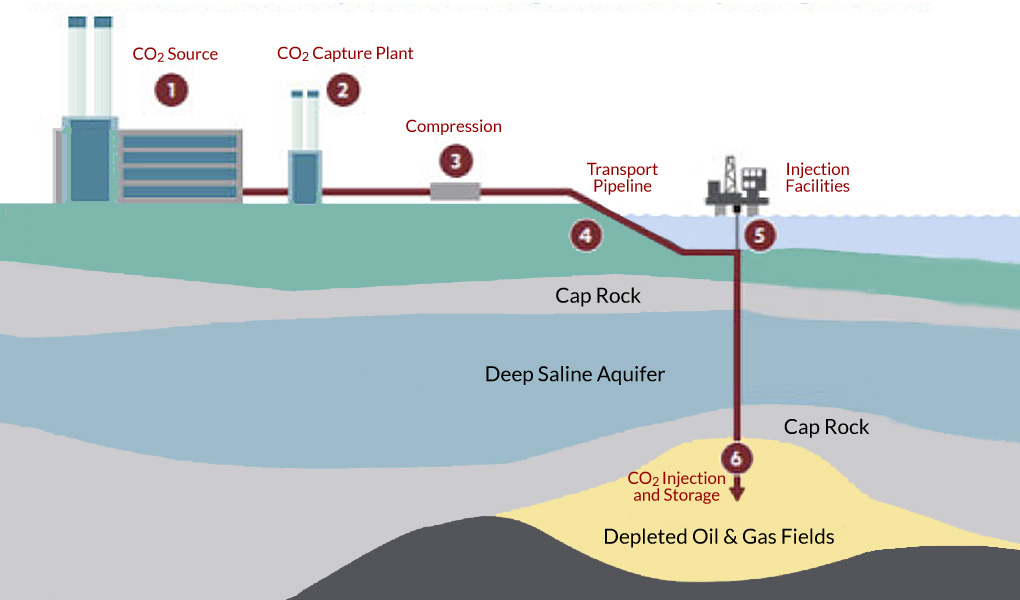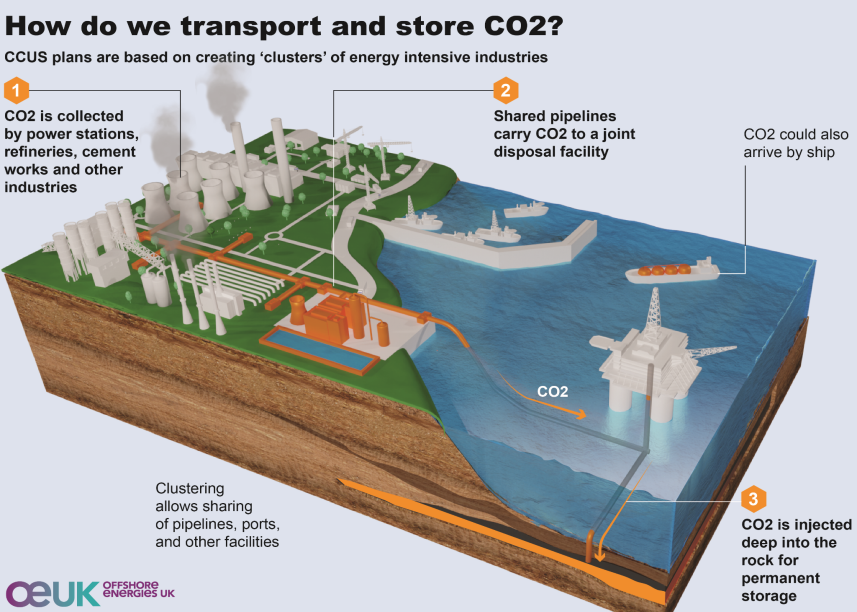





Copyright infringement not intended
https://geospatial-research.com/carbon-storage/
Context: Germany plans carbon capture for industrial sectors, including cement, aiming for carbon neutrality by 2045, while the UAE initiated a project in November 2023 to convert air-extracted carbon into rock.
Details
The CCS Process

CCS employs various techniques to capture carbon emissions
Effectiveness and Concerns
|
Carbon Capture and Offshore Storage (CCS) |
|
|
Key Points |
Description |
|
Capture Technologies |
●Post-combustion: CO2 is removed after the fossil fuel has been burned. Chemical solvents are used to separate CO2 from the exhaust gases, which are then captured. ●Pre-combustion: CO2 is removed before burning the fossil fuel. The fossil fuel is partially burned to form synthetic gas, and CO2 can be captured from this exhaust stream. This method also generates hydrogen. ●Oxyfuel combustion: Fossil fuel is burned with almost pure oxygen, producing CO2 and water vapour. The water is condensed, and CO2 is separated and captured. This method is efficient but energy-intensive. |
|
Transport |
●Pipelines: Preferred method for onshore and near-shore storage. ●Ships: Used for transporting CO2 over longer distances or to offshore storage locations. ●Considerations: Distance, infrastructure availability, safety regulations. |
|
Storage |
●Depleted oil and gas reservoirs: Existing infrastructure can potentially be repurposed for CO2 storage. ●Saline formations: Deep underground rock formations with briny water, offer large storage capacity. ●Selection criteria: Geological stability, capacity, injectivity (ability to accept CO2), and risk of leakage. |
|
Monitoring and Verification (M&V) |
●Monitoring: Regular assessment of pressure, temperature, and CO2 plume movement at the storage site. ●Verification: Independent confirmation of CO2 storage and potential leakage risks. ●Technologies: Seismic monitoring, wellbore integrity checks, satellite observations. |
|
Regulatory Framework |
●Permitting process for capture facilities, transport pipelines, and storage sites. ●Liability and risk management frameworks. ●CO2 property rights and ownership during storage. ●Monitoring and reporting requirements. |
|
Costs and Economics |
●Capture technology costs: Vary depending on the chosen technology and application. ●Transport costs: Pipeline construction and operation or ship transportation fees. ●Storage costs: Site selection, well drilling, and long-term monitoring. ●Potential economic benefits: Carbon credits earned through CO2 capture and storage. |
|
Environmental Considerations |
●Energy use for capture processes: Can increase power plant emissions if not addressed with renewable energy integration. ●Leakage risks: Accidental or gradual release of stored CO2, potentially impacting ocean acidification or local ecosystems. ● Habitat considerations: Careful site selection to avoid sensitive marine environments. |
Conclusion
Must Read Articles:
Carbon Capture and Storage: https://www.iasgyan.in/daily-current-affairs/carbon-capture-and-storage#:~:text=Carbon%20capture%20and%20storage%20
Carbon Capture Utilisation Technologies: https://www.iasgyan.in/daily-current-affairs/carbon-capture-utilisation-technologies-26
|
PRACTICE QUESTION Q. Considering the complexities of marine ecosystems and potential changes in ocean chemistry due to CO2 injection, what research is needed to fully understand the long-term environmental consequences of large-scale offshore Carbon Capture and Offshore Storage (CCS) deployment, and how to ensure robust mitigation strategies are in place to minimize potential risks? |







© 2025 iasgyan. All right reserved